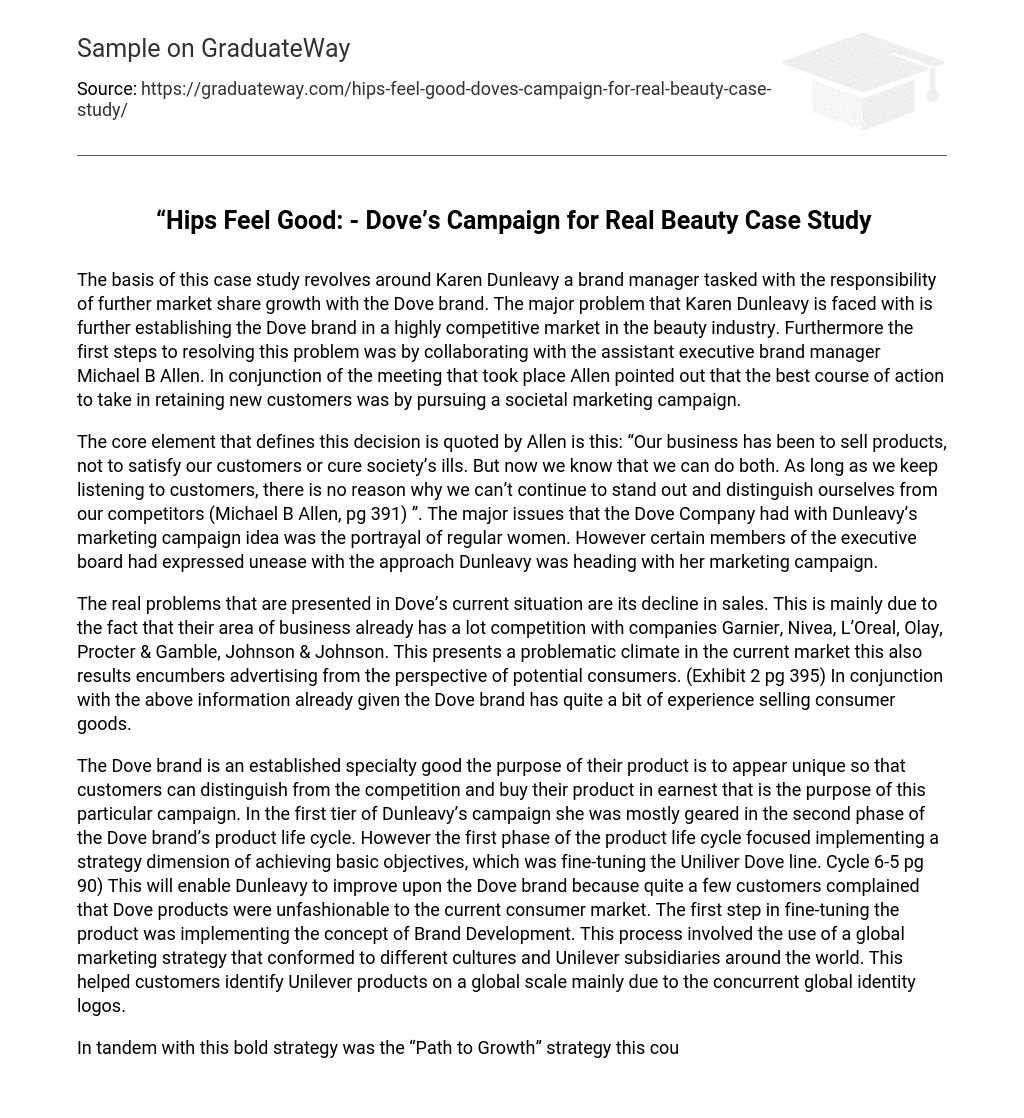The case study focuses on Karen Dunleavy, a brand manager trying to increase market share for the Dove brand. She faces the challenge of establishing the Dove brand in a highly competitive beauty industry. To address this issue, Dunleavy collaborates with assistant executive brand manager Michael B Allen. During their meeting, Allen suggests that a societal marketing campaign is the most effective way to retain new customers.
The key point mentioned by Allen is that their main focus has always been selling products rather than satisfying customers or addressing societal problems. However, they now understand that they can achieve both goals by actively listening to customers. This will help them maintain their unique position in the market compared to competitors (Michael B Allen, pg 391). The Dove Company had concerns about Dunleavy’s marketing campaign, particularly regarding how it portrayed regular women. Some members of the executive board were also uneasy about the direction Dunleavy was taking with her campaign.
The main issue faced by Dove is its decrease in sales, which can be attributed to strong competition from Garnier, Nivea, L’Oreal, Olay, Procter & Gamble, and Johnson & Johnson. This intense competition poses challenges in the current market and hinders advertising efforts aimed at potential consumers (Exhibit 2 pg 395). Additionally, Dove has significant experience in selling consumer goods.
The purpose of the Dove brand is to appear unique, allowing customers to distinguish it from competitors and choose to buy their product. This particular campaign focused on the second phase of the Dove brand’s product life cycle. However, the first phase of the product life cycle was about implementing a strategy to achieve basic objectives, which involved fine-tuning the Unilever Dove line (Cycle 6-5 pg 90). This was done to address customer complaints about Dove products being unfashionable for the current consumer market. The first step in fine-tuning the product was implementing the concept of Brand Development. This involved using a global marketing strategy that was adaptable to different cultures and Unilever subsidiaries worldwide. This helped customers recognize Unilever products on a global scale, thanks to the concurrent global identity logos.
The company implemented the “Path to Growth” strategy to reduce the number of products from 1,600 to 400. This strategy was complemented by the appointment of brand managers, who were responsible for determining the most suitable marketing direction for each region. This strengthened the relationship between brand development and brand building. Additionally, the Dove research study helped Dunleavy obtain a more accurate understanding of their typical female customer.
The foundation of this research study is based on four questions: “What do women mean by beauty?”, “How happy are they with their own beauty?”, “How does a woman’s sense of her own beauty affect her well-being?”, and “What influence does mass media and pop culture have on the perception of beauty?” (The Dove Research Study pg 394, 396). In conjunction with this study, Unilever hired a global research firm to investigate the primary observation regarding the balance between societal beauty standards and women’s perception of beauty. Unilever aimed to thrive in the mature product life cycle, indicating their focus on achieving an impressive 80% increase in revenue.
Additionally, the product life cycle of Unilever illustrates that the company executed a customer-driven marketing strategy to establish a strong relationship between the seller and the customer through the campaignforrealbeauty.com website. During the decline phase of the life cycle, Unilever is still committed to delivering high-quality products. (Cycle 6-5 pg 90) Considering the new campaign strategy, the most suitable alternative would be for Dove to return to its conventional mode of operation. Nevertheless, this move would result in facing intense competition within the advertising sector.
Despite the potential impact on Dove’s financial objectives, I strongly support “The Campaign for Real Beauty” as a valuable strategy. It not only retains loyal customers and attracts new ones but also enhances the company’s perceived social responsibility. Repositioning the Dove brand has increased market share in the beauty industry, with no comparable alternatives to what Dunleavy and their team have achieved.
Source:
Peter, J. P., & Donnelly, J. H., Jr. (2007). Marketing management: knowledge and skills. (8th ed.). New York: McGraw-Hill/Irwin.
“Our business has been to sell products, not to satisfy our customers or cure society’s ills. But now we know that we can do both. As long as we keep listening to customers, there is no reason why we can’t continue to stand out and distinguish ourselves from our competitors.”
Michael B Allen quote Case 14 pg 391
Peter, J. P., & Donnelly, J. H., Jr. (2007). Marketing management: knowledge and skills. (8th ed.). New York: McGraw-Hill/Irwin Case 14 Exhibit 2 Examples of Competitor Advertisements PG 395
Chapter 6 Cycle 6-5 pg 90 Marketing Highlight: Marketing Strategy Implications of the Product Life
Section V The Dove Research Study pgs. 394, 396
Case 14 The Path to Growth pg 391 Peter, J.P., & Donnelly, J.H., Jr.(2007).Marketing management:knowledge and skills.(8th ed.).New York:McGraw-Hill / Irwin Case
Exhibit2 ExamplesofCompetitorAdvertisementspg395





